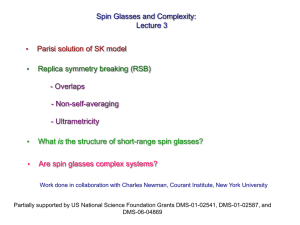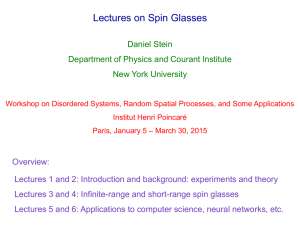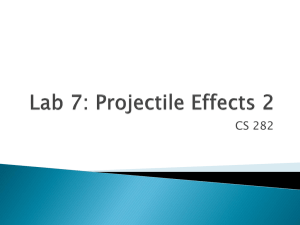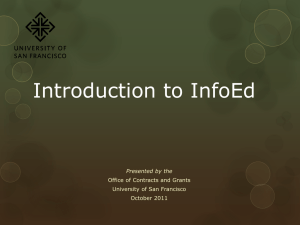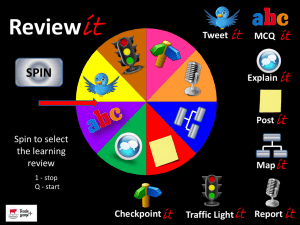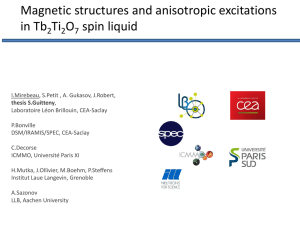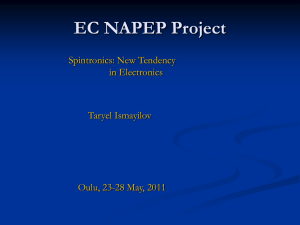Spin Glasses * Redux J. A. Mydosh Kamerlingh Onnes Laboratory
advertisement
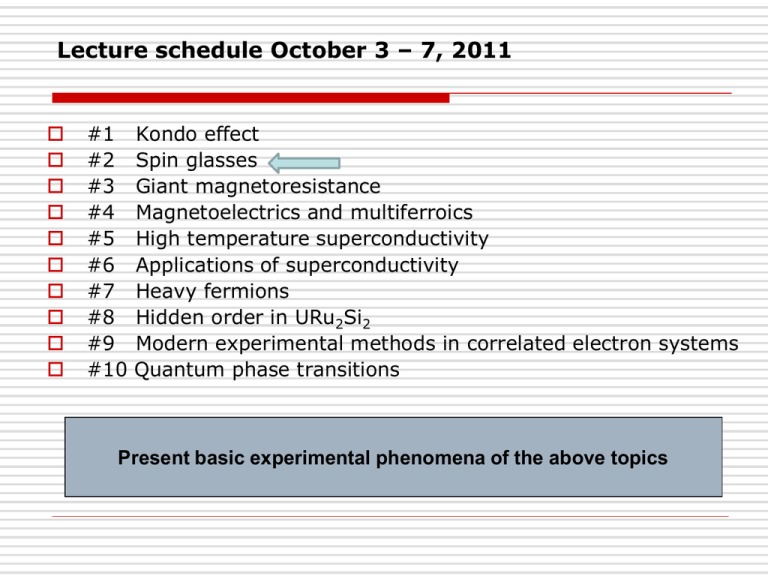
Lecture schedule October 3 – 7, 2011 #1 #2 #3 #4 #5 #6 #7 #8 #9 #10 Kondo effect Spin glasses Giant magnetoresistance Magnetoelectrics and multiferroics High temperature superconductivity Applications of superconductivity Heavy fermions Hidden order in URu2Si2 Modern experimental methods in correlated electron systems Quantum phase transitions Present basic experimental phenomena of the above topics #2] Spin Glasses • Experimentally driven 1972; theoretical explained beginning in 1975 onwards… Still questions today! • Last of the classical (not quantum, but temperaturedriven) phase transitions into a new state of matter using novel classical statistical mechanics. • “Order”, an unusual phase transition, out of randomness, competing interactions, and frustration. • A frozen glass of spins! • Very large-scale computer simulations. Spin Glasses – Redux J. A. Mydosh Kamerlingh Onnes Laboratory Leiden University, The Netherlands • • • • • • • • Introduction: What is a spin glass. History of spin glasses. Basic experimental properties. Early theories and models. Present state of spin-glass behavior. Chiral glasses. Quantum spin glasses. Future What is a Spin Glass • Novel, yet classical, phase transition into a new state of matter: A frozen glass of spins. • Theoretical models with solutions of the phase transition available for spin glasses. • N.B. differences from real (window) glasses – no simple model solution or theory. Everybody loves a solvable model – almost. Cluster SG with ferromagnetic (mictomagnetic) regions 2 3 i i Two valley landscape of ferromagnet Development of multi-valley landscape Slow dynamics Non-equil. “aging” Summary History of Spin Glasses • V. Cannella and JAM, Phys. Rev. B 6, 4220 (1972 ). • S.F. Edwards and P.W. Anderson, J. Phys. F 5, 965 (1975). • K. H. Fischer, Phys. Rev. Lett. 34, 1438 (1975). • D. Sherrington and S. Kirkpatrick, Phys. Rev. Lett. 35, 1792 (1975). • And then all hell broke loose! G. Parisi, Phys. Rev. Lett. 43, 1754 (1979); ibid 50, 1946(1983). • See for experiment: I.A. Campbell and D.C.M.C. Petit, J. Phys. Soc. Jpn. 79, 011006 (2010). • See for theory: H. Kawamura, J. Phys. Soc. Jpn. 79, 011007 (2010). ac-linear susceptibility (hac-->0) for AuFe alloys V. Cannella and JAM, PRB 6, 4220 (1972). Field dependence of ac-susceptibility for AuFe In external field of 1000 G V. Cannella and JAM, PRB 6, 4220 (1972). Evolution of Early Spin Glass Theories Si (0) Sj (t ) T C for E-A KF (1975): “OPEA” q lim t ergodic system q Si >T 2 C and χLR = C/T[ 1 – q(T)]. S-K (1975): q = qEA a constant, RSB scheme incorrect, unstable solution for SG state. GP (1979): Spontaneous-RSB scheme OP is q(x) is a continuous variable as RSB matrix blocks ∞, 0 < x <1 (probability distribution of overlaps P(q) or x is time scale). F-H (1986): Low energy excitations of droplet of reversed spins E ~JLy , random changes (δJ or δT)Ld/2, if d/2 > y, have SG instability. EA & SK models and Fisher calculation: Random bonds of Ising classical with spins = ½ , ∞ or +/-1. Bonds form a Gaussian probability distribution. Solution of free energy (F) via replica trick for partition function (Z) F = -kBTlnZ. Results for χ and C Introduction to S-K model – PRL 35, 1792(1975) Early Theories and Models – Ising Spin Glasses: A difference in predictions Replica Symmetry Breaking Model: G. Parisi, PRL 50,1946(1983). Continuous order parameter-q(x), i.e., many equilibrium states related to probability distribution of overlap of the magnetization in the different state. Predicts SG phase transition also in magnetic field. Droplet Model: D. Fisher and D. Huse, PRB 38, 386(1988). Scaling of low-lying large-scale droplet excitations. Clusters of coherently flipped spins. Magnetic field destroys the SG phase, only a dynamical crossover. How to tell the difference via experiment or simulation??? For FSS see below No crossings Controversy !!! Indeed phase transition in small external fields outside of MFT. (Leuzzi, Parisi PRL (2009)). Experiment not yet found! Finite size scaling: Is there a SG phase transition? P. Young, lecture notes (2010) What is SG chirality? See below Which correlation diverges first: SG or CG ? Is there a CG phase transition??? Two traditional questions, yet to be answered in 2012 What about a chiral spin glass? Need experiment? Basic Experimental Properties Four key experimental characteristics of spin glass: 1) 2) 3) 4) Frequency dependent cusp in ac-susceptibility; divergence in non-linear susceptibility. Difference between field cooling (FC) and zero field cooling (ZFC) magnetization. Broad maximum in specific heat, non-critical behavior. Metastable and aging low-temperature behavior. 1) 2) 3) 1 4a) i ta = tw + t 4b) . 1 RSB predicts phase transition Mean-field H – T phase diagram for Ising SG. (de Almeida-Thouless line) Droplet predicts crossover, no RSB for phase transition Present experimental and numerical simulations favor droplet model Mean-field H – T phase diagram for isotropic Heisenberg SG (GabayToulouse line) Onset of transverse SG order Crossover to de A -T line Mean-field H – T phase diagram for weakly anisotropic Heisenberg SG de A - T line transition to longitudinal spin order Experimental situation for AuFe, CuMn, AgMn, etc. SG’s Critical exponents of SG phase transition at ε = (T – TC)/TC from susceptibility, magnetization and specific heat measurements as function of T and H in dimension d • β is order parameter exponent • γ is susceptibility exponent • α is specific-heat exponent • δ is magnetic-field exponent • η is correlation function exponent • ν is correlation exponent • ψ is free energy-barrier length-scale exponent • θ is droplet length-scale “L” These critical exponents are related to each other by “scaling relations”, e.g. ν = γ/(2 – η), α = 2 – dν, β = γ/(δ – 1), etc. Ising SG TC = 0 3D Heisenberg SG’s with weak anisotropy K(0)/TC Simulations [PRB 80,024422(2009)] (483 & 107CPU hr.) based upon EA model show finite TC with SG OP: qiµν = Siµ(1)Siν(2) yet a new chiral OP appears with better agreement to experiment of critical exponents. Chiral Glasses Kawamura [PRL 68,3785(1992)] proposed a multispin “handyness” of the non-collinear 3D Heisenberg E-A model, i.e., the spin structure is right- or left-handed. Chirality with its associated OP. κiµ = Si+µ ∙ (Si x Si-µ) where µ is a lattice direction unit vector of the spin Definition of Chiral OP: qCG,iµ = κiµ(1) κiµ(2) Competition between spin OP and Chiral OP as determined by their correlation lengths, ξSG and ξCG. Present State in 2010 of Spin-Glass Behavior • Controversy – numerical simulations of 3D Heisenberg SG bigger and longer. • Little new experiment on canonical SG’s. • SG behavior found in many new systems, e.g., disordered magnetic nanostructure materials. • Interest in chiral and quantum SG’s but mainly from theoretical point of view. Quantum Spin Glasses • What is a quantum SG • Theory can calculate but experiment is lacking • Is there a good quantum SG in nature? • Disappointment with LiHoxY1-xF4 1 Not a canonical SG, see PRL105,107203(2010)!!! Ge2 s Canfield et al., PRB(2000). Future • Need new experiments, yet very time and energy consuming. • Ongoing simulations on larger and larger parallel processing computers. • Need final proof of line dA-T. • Need final proof of chiral spin glass. • Experimental search for a quantum spin glass has not yet been rewarded. • Nanostructured spin glasses – size effects. OPEN TO BE USED To be used Some conclusions (PY)




